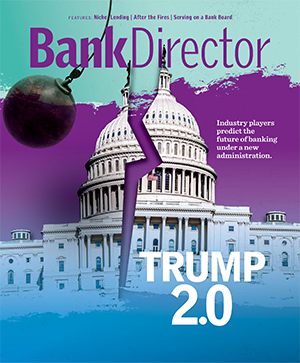John Engen is a contributing writer for Bank Director. He has more than 30 years of experience as a business journalist, writing for a variety of newspapers and magazines, and was a foreign correspondent for the Associated Press. He graduated with a degree in economics and international relations from the University of Minnesota and did his post-graduate work in Asian studies at the University of Hawai’i.

Capitalizing on Disruption: California’s Entrepreneurial Five Star Bancorp
James Beckwith, CEO of Five Star Bancorp, is always looking for opportunities to grow his $3.6 billion Rancho Cordova, California-based franchise. A decade ago, he stumbled across a profitable niche financing manufactured housing parks that has turned into a core growth engine. Five Star also made hay during the pandemic originating loans under the federal government’s Paycheck Protection Program, when small business owners couldn’t get bigger banks to pick up the phone.
For a while, one long-term goal seemed unattainable: Setting up shop in the San Francisco Bay Area. The company’s stated goal is to be the preeminent bank in northern California, and that’s tough to do without a Bay Area presence. But how could a small bank from suburban Sacramento gain a foothold?
“Realistically, how would we get someone from one of the banks there to say, ‘Yeah, let’s leave our current situation and join Five Star Bank,’” Beckwith says.
Then March 2023 happened. Silicon Valley Bank collapsed over liquidity concerns, followed quickly by Signature Bank and then First Republic Bank — all institutions with large presences in the Bay Area.
“Suddenly, there were a lot of disrupted customers and a lot of really good bankers in the market who didn’t have a horse to ride,” Beckwith recalls. “We were ready to respond quickly.”
Less than three months later, a team of five former Signature bankers signed on as the initial building blocks in what has become a full-out assault on the Bay Area banking market. Five Star now has 20 business development officers, or BDOs, working the metropolitan area’s small business community, most of them refugees from Signature or First Republic. The bank later this year will open a branch in downtown San Francisco.
“If there’s one thing we’ve tried to be consistent about over time it’s being opportunistic and taking advantage of market displacements,” Beckwith says.
Five Star’s Bay Area buildout represents a massive ramp-up for a company with around 190 employees and a market capitalization of $500 million, but it doesn’t necessarily feel out of character to analysts who follow Five Star. The company, which in 2021 did the first post-pandemic bank IPO and then did a secondary offering in March 2024 to help finance its expansion, has a reputation for successfully seizing on opportunities when they emerge.
“It’s a little surprising in the sense that they’ve historically been centered on the Sacramento area,” says Gary Tenner, a managing director and senior research analyst with D.A. Davidson Co. “But it’s also part of the nature of Five Star’s management and board to say, ‘There’s all this talent shaking loose here. How can we take advantage of that to grow our business?’”
The 25-year-old company is defined and differentiated by what it does and how it does it. A powerhouse lending niche in manufactured housing provides much of its earnings oomph with relatively low risk. Equally important is a culture that is centered firmly on customers and grounded in immediacy and purpose. Five Star’s incentive scheme doesn’t cap how much its bankers can make, inspiring them to produce. A laser focus on credit quality and an engaged board minimize the downside risks and drive further growth. Most important might be its ability to quickly capitalize on opportunities.
In 2023, Five Star’s performance was strong enough to rank No. 18 overall in Bank Direc-tor’s RankingBanking study of the 300 largest publicly traded banks and fifth among banks under $5 billion in assets. The ranking, compiled by Piper Sandler & Co. using S&P Global Market Intelligence data, combines a variety of metrics around profitability, capital adequacy and asset quality to derive a composite score.
Five Star reported a return on average assets in 2023 of 1.44% and a return on average equity of 17.91%, both figures among the top 50 for all public banks.
Commercial real estate (CRE) concentrations, as for many community banks, attract scrutiny. Fully 86.8% of Five Star’s loan portfolio at the end of 2023 was tied to CRE, valued at 682.7% of its risk-based capital, according to company filings. That was well beyond the regulatory guidance sub jecting banks with CRE loans of more than 300% of risk-based capital to greater supervisory scrutiny. At a time of gloom and doom around the sector, such exposures can spark worry.
“The biggest concern I hear from investors is, ‘How does this play out over time in terms of CRE concentrations?’” says Andrew Terrell, a managing director at Stephens. “There’s a lot of angst about CRE.”
Judging by the numbers, however, credit quality on the $2.69 billion CRE portfolio hasn’t been an issue. Nonperforming loans at the end of 2023 accounted for just 0.06% of loans and other real estate owned, among the lowest in Bank Director’s ranking.
“If you just pulled up our call report, you’d be like, ‘Yikes, they are seriously concentrated in CRE,’” admits Heather Luck, Five Star’s chief financial officer. “But it’s all about how we manage the program and the granularity of the loans.”
A Unique Niche
To understand what drives Five Star’s success in CRE, look first at the portfolio’s composition: Office loans account for just 5% of CRE loans and are mostly for two- or three-story suburban office buildings, not downtown high rises. Some targeted customer niches, including faith-based communities, multifamily, industrial and mini-storage facilities, each generate about 7% of the company’s CRE loans. Most of the rest, a whopping 44% of the entire CRE portfolio, are loans to manufactured home communities and RV parks.
The borrowers are professional park operators, not people who own mobile homes. Most of those firms own dozens, if not hundreds, of small housing communities that charge homeowners — ranging from retirees to two-income families who typically pay between $100,000 and $200,000 for their abodes — $500 or $600 per month in rent for the space and hookups. In total, there are about 44,000 such communities around the country, most of them mom-and-pop shops, and the space is consolidating rapidly.
Five Star picks its clients carefully, working only with experienced park operators. A typical loan might be $2 million to finance the acquisition of a park or upgrade its utilities or pavement so the operators can charge a bit more in rent. The credit quality is superb, Beckwith says, the data easy to track and digest.
To add comfort, Five Star’s team re-under-writes every park loan worth more than $2 million annually and performs regular site inspections. It’s also a national business: 42% of the manufactured housing park portfolio comes from out-side of California, providing valuable geographic diversification.
“CRE is the lifeblood of most community banks. It’s how you diversify inside CRE that matters,” says Robert Perry-Smith, Five Star’s chairperson and a longtime accountant to the banking industry. “We believe there is a high degree of safety in mobile home communities. If everything goes to heck in a handbasket, people still need a place to live, and this is pretty affordable.”
By all accounts, regulators understand the portfolio’s dynamics well enough to approve.
“They’ve taken a lot of time educating regulators on the types of loans they’re underwriting,” Terrell says, and it appears to have worked. “It seems like there’s a lot of regulatory support for them being at the level they’re at, as opposed to pushing them lower.”
“Fell Into” the Business
Beckwith admits he “fell into” the business after a long-time client asked if Five Star would re-finance some mobile home park notes that were coming due. He reviewed the underlying assets and was impressed. Even during the Great Recession, manufactured housing held its value. “They all underwrote extremely well — very granular rents, stable occupancy, good yields. I thought, ‘Wow, I wonder if they’re all like this? Maybe we should do more of them.’”
Five Star began lending to the niche in Sacramento late last decade and did a good job. As the bank’s reputation and knowledge base grew, customers came from around the country. At the end of 2023 it had about $1.2 billion in loans to manufactured home communities and RV parks on the books, with an average loan size of about $2.4 million.
Most of those borrowers value the relationship enough to move their core deposits to Five Star as well. While the company doesn’t break out earnings from the business, Terrell estimates it generates between 35% and 45% of net income.
“They’re probably the only bank I’ve dealt with that is totally committed to the business,” says John McDougall, principal and CEO of Monte Christo Communities, a Sacramento-based owner/operator of 91 manufactured housing communities in the western part of the country and a Five Star client. “They understand the business completely and know where the risks lie.”
Born for CRE
Five Star was founded in 1999 by a pair of real estate professionals who thought Sacramento needed a bank attuned to their industry’s needs. Over time, the company expanded its branch presence methodically, and today boasts five Sacramento area offices and three more to the north in Yuba City, Chico and Redding. CRE is the focus, with some basic small business lending scattered in.
It’s what Beckwith calls a “branch-light” model. “Each of our offices, on average, holds a lot of deposits, and that creates a lot of efficiencies,” he says. Indeed, the company’s efficiency ratio, a measure of noninterest expenses over revenues, was 40.4% in 2023, and that included the Bay Area expansion costs. The industry average for the year was 57.5%, according to the Federal Deposit Insurance Corp.
Technology is critical to the operation. Five Star is a big user of nCino’s cloud banking platform, deploying it on both the lending and deposit sides. Beckwith accesses it daily on his tablet to move loans through the pipeline quickly. “It creates efficiencies in terms of how we approve or reject oppositions and gives us actionable information more quickly than before we used it,” he explains. “That builds stronger connections with customers and turns up the velocity
on what we’re able to do and drives growth.”
The company also recently implemented Axiom, a financial reporting system, to help turn around such back-office tasks as budgeting and forecasts quickly. “I have a bunch of really talented peo-ple, and it killed me to think they were spending time checking formulas on a spreadsheet instead of making things better for customers,” Luck, the CFO, says. “It has improved my team’s efficiency significantly.”
Work Hard, Play Hard
The technology spending goes into supporting a customer-first culture that feels more developed and mature than many community banks. “We’re big believers in creating relationships built on trust and empathy,” Beckwith says. “It’s a commodity business, so you have to have expertise in the verticals you participate in and differentiate yourself with service and creating a strong reputation.”
An in-house mantra, “speed to serve and certainty of execution,” comes with a commitment to respond to queries from customers and coworkers within 24 hours. “There’s no 1-800 number, no ‘what’s your social and mother’s maiden name,’” says Shelley Wetton, Five Star’s chief marketing officer. “It’s concierge banking — high tech, high touch. The client has the phone number of someone who knows them.”
That responsiveness has paid dividends. For example, Five Star originated $175 million in PPP loans during the
pandemic, 40% to small business-es that weren’t customers before. “The big banks didn’t answer the phone and we did,” Luck says.
People make the model work, and a large amount of effort goes into hiring and development. Five Star’s culture is high-octane and provides high-producing BDOs with uncapped earnings potential. “Our business development folks eat what they kill,” Beckwith explains. “My job is to make sure they’re successful.”
It’s a work-hard, play-hard place with connections and structure. There are book clubs and a new running team that has about 30 employees training together for half marathons. “We hire a lot of college athletes, people who are really driven and focused,” Wetton says.
DJ Kurtze, a former Signature banker who signed on last year as Five Star’s San Francisco Bay Area president, says the company “feels like a startup but it’s not, because the bank is well-established and has all these processes in place.”
The board sets part of that tone and isn’t afraid to get its hands dirty. The 11-member group includes accountants, f
ormer bankers, CRE industry players and executives from other industries, and is actively on the hunt for growth opportunities. For example, Vice Chairperson Randall Reynoso, a retired executive vice president for Wells Fargo & Co.’s Bay Area business bank, introduced Beckwith to Kurtze several years before Signature’s collapse and helped recruit him.
“As a board, we look at the Bay Area as an external growth strategy,” Perry-Smith says. “It’s an opportunity to go out and build a large team with-out buying a bank and all that entails.”
Face of the Franchise
Five Star is a group effort, but Beckwith, who favors golf over running, is the chief cultural orchestrator and the face of the franchise. He’s on the go constantly, meeting with and supporting BDOs trying to land new business or meeting with community groups, and spends many of those golf outings with prospective clients or mentoring newer employees. He’s happiest, Wetton says, when his calendar is full.
Beckwith has a reputation for both backslapping and knowing his numbers. “James is intellectual. He’s very entrepreneurial and risk-averse, and he’s very committed to his team,” Perry-Smith says.
An accountant by training and CEO since 2003, Beckwith is an alum of Vistage, a CEO training and advisory program (he had to quit when Five Star went public). He’s also an avid reader. Among his favorites are books by management guru Patrick Lencioni, including “The Ideal Team Player,” which Beckwith says lays out three “fundamental attributes” that are critical to employee success: Being “hungry, humble and smart.” It’s a philosophy that, among other things, emphasizes humility with clients and “emotional intelligence, being able to read a room.”
Employees are asked to read Lencioni’s books. Many participate in an eight-month development program “to create a common culture and language,” Beckwith says. It’s not a place for slackers. At Five Star, “the worst thing you can do is let your colleagues or clients down,” he adds. “We’re not for everybody. You have to be continuously im-proving. You can’t hide here.”
While training is important, Beckwith says hiring people with communication skills and “grit” matters more in a business where doors are tough to open and frequently get slammed shut. “Grit is more important than anything,” he says. “You want to hire people who can tough it out and not lose confidence easily.” The company puts prospective employees through extensive interviews and employs predictive indexing to better understand their makeups “and ensure that their world view is consistent with what the job requires.”
“We Believe in San Francisco”
The emphasis on sales isn’t lost on Kurtze, who joined Five Star in June 2023. He’s recruiting Bay Area bankers and says the uncapped incentive plan is “huge” for helping to land top talent. Most banks will limit incentive payouts to a percentage of annual salaries.
“If you really want to be a high-growth sales organization, it’s an important piece,” he says. “We’re hiring bankers who want to grow. They’re not just comfortable knowing they’ll get up to 50% of their salary every year if they stay under the radar. [The lack of caps] incentivizes them to grow.”
The team has its work cut out for it. San Francisco’s reputation as a good business city has taken a hit in recent years, and banks have been shuttering more branches than they’re opening. More than a few observers have questioned Five Star’s move, but for Beckwith it represents a shot at a market with $467 billion in deposits that he never thought he’d get. “It’s a great city,” he says. “It has some issues, but it had issues 40 years ago.”
Things appear off to a good start. The goal is to do more C&I lending than CRE in the Bay Area and raise core deposits. To boost its name recognition in the market, Five Star began underwriting the San Francisco Giants’ pregame shows. Kurtze voices the ads, which end with “We believe in San Francisco.” This fall it will double down with the opening of its first Bay Area branch at 345 California Center in the heart of the financial district.
Those things cost money. Terrell estimates that Five Star’s expenses will rise 13% in 2024, due mostly to the Bay Area expansion, but he expects revenues to grow at twice that pace. They are “still generating positive operating leverage while rein-vesting,” he says.
And from there? To date, Five Star’s opportunistic streak has been limited to organic initiatives. But the Bay Area remains disrupted, and more than a few banks are struggling. “With the 2023 failures, everyone has been painted with the same brush,” Perry-Smith says, and that feels like another chance to capitalize on chaos, this time via acquisition. M&A “is absolutely in our strategic plan,” he adds. “This company is not about growing slowly.”


